
How to Use Events in Sellify AI Templates
Description:
Learn how to integrate and configure Events within Sellify AI templates to flag events and get notifications based on customers’ responses.
What Are Events in Sellify AI?
Events are integral to the template creation process and allow you to get notifications based on specific customer interactions and conversational responses.
Events include both required master events and optional custom events, each serving distinct purposes in driving targeted communication.
Why Use Events in Templates?
Embedding Events in templates enables you to:
Configure Notifications: Activate email notifications when your event is detected
Create Response Restrictions: Control how a conversation is replied to based upon event detection (enable or disable autoresponse).
Flag conversations: Get alerted when certain topics arise in your customer’s conversations and control how those events are handled.
Where to Access Events in Sellify AI
Log into Sellify AI: sellifyai.com/login
Navigate to Templates:
Go to Campaigns > Templates
Or visit: sellifyai.com/campaigns/templates
How to Use Events Within a Template
Step 1: Select or Create a Template
Click Create Template or choose an existing template to edit.
Example: Select a Service Upsell or Winback Offer template.
Step 2: Define the Conversation Flow
Add your conversation steps as usual, including greetings, questions, and CTAs.
Step 3: Add Events to the Template
Scroll to the Events Section within the template creation process.
You will see two categories:
Required Events: These events must be included in every template and cannot be removed. Examples include:
Interested
Not Interested
Suggested Events: Additional events that can be added based on the campaign objective (these can be deselected by the user).
Custom Events: These can be added if the suggested events do not cover your needs.
Configure notifications for each event:
Send Email on Detection: Notify internal users when an event is triggered.
Disable Other Responses: Prevent further responses after specific events.
Enable Manual Follow-Up: Mark the event for manual review and intervention.
Step 4: Testing Event Functionality
To validate event functionality, you can update and add it to a test campaign.
Test key flags, such as Send Email or Disable Response, to verify that notifications are correctly triggered.
Example Events and Use Cases
1. Interested (Required Master Event)
Trigger: Customer expresses interest in proceeding with a service or offer.
Action: Send an automated follow-up email to the assigned salesperson with next steps.
2. Not Interested (Required Master Event)
Trigger: Customer declines the offer or service.
Action: System will log the response and prevent further messaging regarding that specific offer.
3. Conversation Escalated (Complaint or Dispute)
Trigger: Customer expresses frustration or dissatisfaction.
Action: Notify the service team for immediate intervention.
6. Custom Events
Trigger: Defined by user-specific needs or unique business processes.
Action: Assign a custom response.
Best Practices for Using Events
Validate Event Functionality: Test notification settings to confirm that email and response flags operate as intended.
Monitor and Adjust: Regularly review event performance and adjust triggers based on campaign data.
Frequently Asked Questions
Q: Can I assign multiple events to a single template?
A: Yes. Templates can contain multiple events, each with distinct triggers and messaging logic.
Next Steps
✅ Define key customer actions and corresponding event triggers
✅ Embed events in your conversation flow templates
✅ Test and monitor event performance for ongoing optimization
